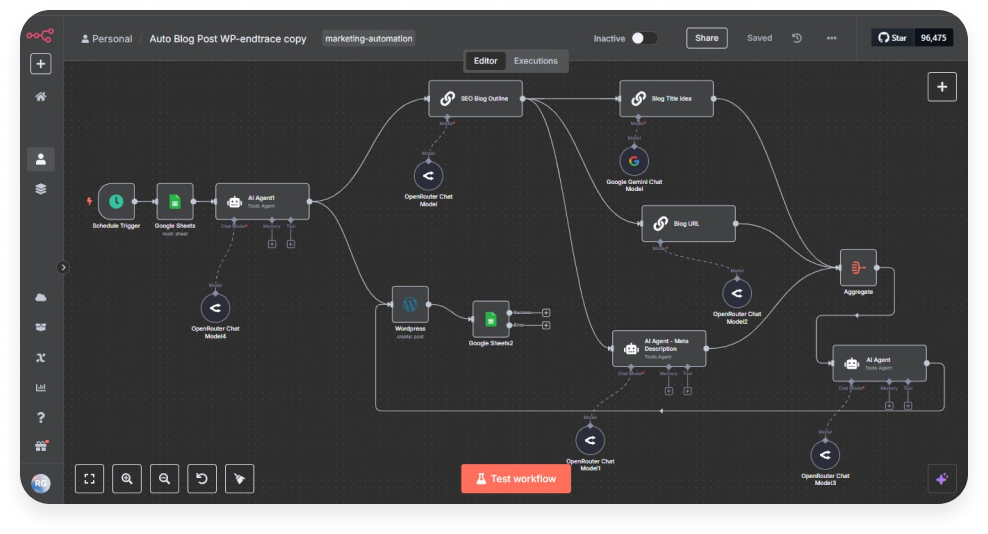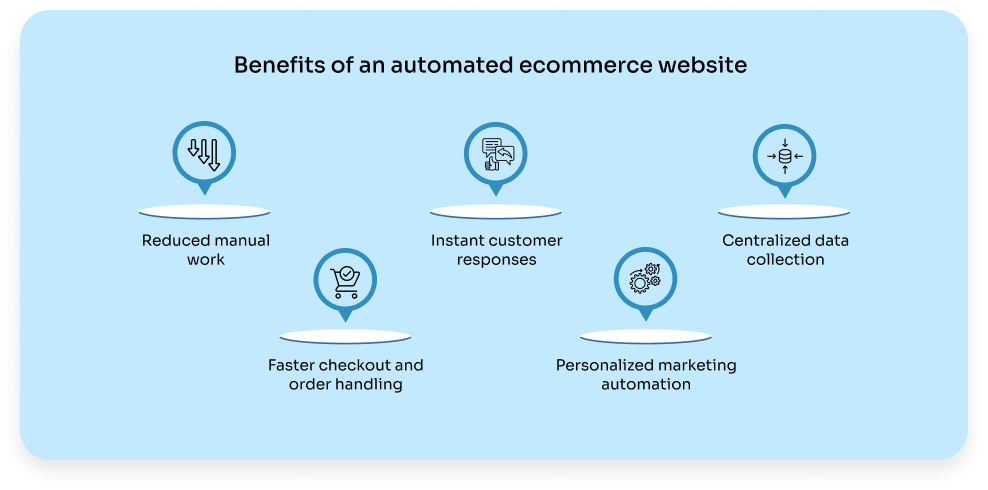I get it.
You’re already running WordPress
Publishing posts, managing WooCommerce orders, syncing customers, handling signups, and juggling plugins to keep things together.
I understand how repetitive it gets: copying leads into a CRM, sending confirmations, updating spreadsheets, posting on social. It works, but it eats into the time you could spend on growth. If you’re also curious about how AI is reshaping this space, check out our Complete Guide to Using AI in WordPress in 2025.
Good News: You don’t need to do all of that manually anymore. With the right automation, WordPress can handle those tasks for you. If you’re exploring modern site setups, you might also like our Headless WordPress Guide.
That’s where Make and n8n come in.
They let you build WordPress automation workflows that connect your site with the tools you already use – Google Sheets, Zoho CRM, Slack, Mailchimp, Trello, and more.
No code, no heavy development, just smart workflows running in the background while you focus on strategy.
In this guide, you’ll learn how to:
- Design workflows that cut hours of manual work.
- Use WordPress automation with Make for drag-and-drop simplicity.
- Explore WordPress automation with n8n for advanced, self-hosted control.
- Automate WooCommerce, CRM, publishing, and backend tasks.
- Decide which tool fits your needs best.
- Scale into advanced automations that connect your entire business.
Automation isn’t just about saving time anymore; it’s about building a smarter WordPress setup that grows with you.
What Is WordPress Automation and How Does It Work?

What I Mean When I Say “WordPress Automation”
Let’s clarify the concept,
WordPress automation is the practice of turning repeated tasks into reliable, hands-off flows. A “flow” is just a set of steps that start with a trigger and run through actions.
For example, a new WooCommerce order comes in, your system checks the order value, pushes the data into your CRM, logs it in a Google Sheet, and pings Slack. That is one WordPress automation workflow.
Common Areas Where Automation Helps :
- Publishing: Automatically share blog posts to social media or newsletters.
- WooCommerce Automation: Sync new orders with accounting software, CRMs, or inventory tools.
- WordPress CRM automation to keep leads segmented and nurtured
- Marketing: Capture leads and automatically enroll them in email campaigns.
- Data Management: Store files, images, or backups in cloud services.
- Customer Support: Create support tickets when customers submit forms.
Automation is not about replacing people; it’s about giving people back their time so they can focus on strategy and growth.
Why Should You Automate Your WordPress or eCommerce Website?
The digital world is moving fast.
If you run a store, you already know the pain of repetitive processes. You can automate eCommerce website tasks to meet three big goals:
Customers expect instant responses, real-time updates, and a seamless experience across devices. To deliver that level of personalization, many businesses pair automation with WooCommerce CRM integration.
Meanwhile, business owners can’t afford to get buried in manual admin work.

Here’s why automation is becoming non-negotiable:
- Scalability
As your site traffic and sales grow, your workload grows too. Automation ensures your processes scale without hiring extra staff. - Error Reduction
Manual data entry leads to mistakes – wrong email addresses, missing invoices, duplicate records. Automation keeps things accurate. - Faster Customer Experience
Imagine a customer orders on WooCommerce and instantly gets added to your CRM with a personalized email. That’s possible only with automation. - Lower Costs
Automating tasks means fewer hours spent on repetitive work, which reduces costs long-term. - Competitive Edge
Businesses using automation simply move faster. They can adapt, launch campaigns, and respond to customers before competitors catch up.
Why Are Make & n8n the Best Tools for WordPress Automation?
There are plenty of no-code automation tools (Zapier, Pabbly, AutomatorWP), but two stand out for serious workflows: Make and n8n.
WordPress Automation with “Make”
Make gives you a visual canvas where you drop modules, connect them, and watch the magic happen. If you prefer no-code automation for WordPress that you can build quickly, Make is a great starting point.
Make (formerly Integromat) is like Lego for automation. You drag modules onto a canvas, connect them visually, and build workflows that run automatically.
- Best for: Non-technical users, small businesses, agencies.
- Strengths:
– Visual drag-and-drop interface.
– 1,000+ pre-built app integrations (WordPress, WooCommerce, Gmail, Slack, Google Sheets, etc.).
– Great error handling (e.g., retry if an API call fails). - Example: Send WooCommerce orders over $500 to Slack, create an invoice in Xero, and email your finance team – all in one flow.
Perfect for content syndication, WooCommerce automation, and simple WordPress CRM automation flows.
WordPress Automation with n8n
n8n is open source and can be self-hosted. If you need flexible, custom logic or want fine-grained control over data mapping, WordPress automation with n8n is excellent.
It’s more technical but offers unmatched flexibility.
- Best for: Developers, agencies, businesses with specific custom workflows.
- Strengths:
– Open-source and self-hostable (no vendor lock-in).
– Advanced data manipulation (great for custom APIs).
– Great when you must automate e-commerce website operations with ERP, warehouse, or custom CRMs - Example: Every time a WooCommerce subscription renews, update customer data in your CRM, send a personalized thank-you email, and adjust inventory in your ERP system.
What Are the Benefits of WordPress Automation Workflows?
Let’s break down how automation actually makes life easier for WordPress site owners.
- Save Hours Every Week
Instead of manually copying leads from forms into your CRM or sending updates to Slack, automation does it instantly. - Improve Customer Experience
Fast, consistent communication makes customers feel valued. Delayed responses? Not so much. - Keep Data Organized
Automation ensures your orders, leads, and content are always in sync across your tools. - Boost Team Productivity
Your team spends less time on copy-paste tasks and more time on projects that actually grow the business.
Comparing Make vs. n8n for WordPress
Both tools are great, but they suit different needs.
If you’re just getting started, Make is easier. If you need total control, go for n8n.
What WooCommerce Automation Workflows Can You Set Up?
WooCommerce is where automation shines the most. Here are real e-commerce flows:
- Abandoned Cart Emails: If a user leaves a cart, trigger an email sequence.
- Inventory Syncing: Automatically update inventory across channels (Shopify, Amazon, eBay).
- Customer Segmentation: Add customers who spend over $500 into a VIP segment for targeted campaigns.
- Accounting Automation: Sync WooCommerce sales with QuickBooks, Xero, or Zoho Books.
These workflows turn your WooCommerce store into a smarter, leaner machine.
How Can You Get Started with WordPress Automation Today?
Ready to dive in? Here’s a step-by-step approach:
- Identify Repetitive Tasks
Write down tasks you repeat daily or weekly. - Choose Your Tool
– Beginners → Make.
– Tech-savvy/custom needs → n8n. - Start Small
Build one workflow, test it, refine it. - Expand
Add more workflows as you get comfortable. - Monitor & Improve
Check logs and performance to avoid errors.
What Common Mistakes Should You Avoid in WordPress Automation?
Automation is powerful, but mistakes happen. Avoid these pitfalls:
- Overcomplicating too soon: Start with simple workflows.
- Not testing properly: Run test data before going live.
- Ignoring data privacy: Make sure your automation complies with GDPR or HIPAA (if applicable).
- Forgetting about maintenance: Review workflows regularly to make sure they still work.
Good hygiene keeps your stack calm whether you choose WordPress automation with Make or WordPress automation with n8n.
What Does the Future of WordPress Automation Look Like?
Automation is evolving fast. Here’s what to expect:
- AI-powered automation: Predictive workflows that adapt to customer behaviour.
- Deeper WooCommerce integrations: Real-time inventory, AI chatbots for support, automated upsells.
- Voice and Chat Automations: Trigger workflows via voice assistants or chatbots.
- More accessible tools: Even less technical setup for beginners.
By 2026, automation won’t be optional – it’ll be the standard.
Final Thoughts
Running a WordPress site doesn’t have to mean endless manual work. With the right workflows in place, you can automate your e-commerce website, CRM, content publishing, and customer support.
Make and n8n are your best allies. Start with one workflow, prove its value, and build from there. Soon, you’ll wonder how you ever managed your site without automation.
Start small: automate one task, measure the time you save, and scale from there. Before long, you’ll wonder how you ever managed your site without automation quietly working in the background.
Now’s the time to move from “just managing WordPress” to building a site that practically manages itself.
By 2026, automation won’t be optional – it’ll be the standard.
FAQs:
You can use no-code tools like Make and n8n to connect WordPress with apps such as Google Sheets, Slack, or CRMs. These platforms let you build workflows that run in the background without writing code.
Make is beginner-friendly and works well for small to mid-sized WooCommerce stores. For advanced needs like ERP or custom CRM integrations, n8n is more powerful because it allows custom logic and self-hosted control.
Yes, by automating publishing, WooCommerce order syncing, and CRM updates, you reduce manual errors and speed up responses. This improves customer experience and helps your site handle growth without slowing down.
Examples of WordPress automation workflows include sending WooCommerce orders directly to a CRM, posting new blog articles automatically to social media, triggering Slack alerts whenever a new signup happens, and syncing inventory across multiple sales channels in real time.
Don’t overcomplicate. Test workflows carefully, start simple, and ensure your WordPress automation workflows follow privacy rules.


 September 22, 2025
September 22, 2025





TEAM id
jnext_services
email us [email protected]
india
+91 98587 63596
United Kingdom
+ 44 77679 57915